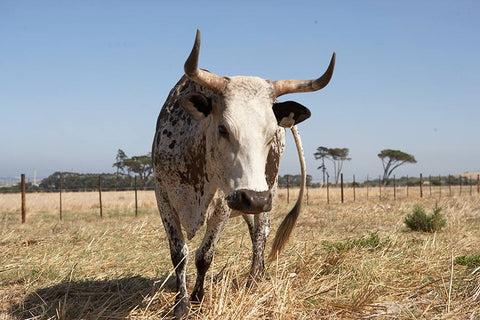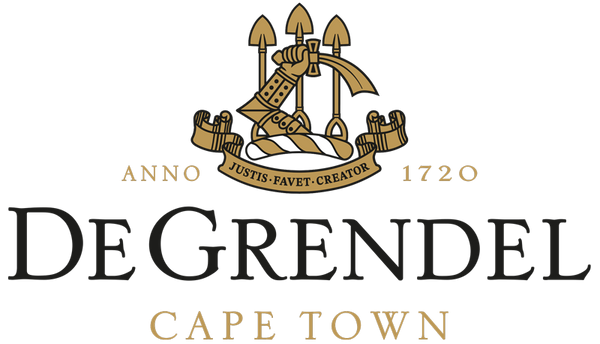
Meet The Cows of De Grendel
Share
The Graaff farm De Grendel has a rich history of breeding award-winning cattle, sheep and horses which stretches far back. In 1892 Sir David Graaff, the first baronet in the Graaff family, bought Friesian stud cows and a prize stud bull in Friesland, Holland. The animals were transported to De Grendel by sea. The beautiful beasts on the farm are in part descendents of the original herd.
Rob Slater, the stud and dairy manager at De Grendel, tells us everything about the oldest Holstein herd in the country.

What is your job at De Grendel?
I am the stud/dairy manager at De Grendel, which means I look after all the cattle on the farm, manage the milking process, the feeding, the rearing of calves, the inseminating and then the admin side; recording all the data, so like each cow has a milking record, and an insemination record etc which is important to log in order to manage De Grendel’s ethics and quality. There are over 700 cows on the farm, including those reared for beef, so yes, I’m always busy.
Do the De Grendel cows produce milk?
Yes, and they are free range, which basically means that they are not forced to live inside, they can lie outside, they have free access to water, they get fed high quality food and they have comfortable sand beds. They do have to be in housing sometimes though to guarantee that they will be high producing, because otherwise they can get heat stress, which not only affects their livelihood but also their milk.

How many pregnancies does one cow go though in a year?
The cows do have to be pregnant in order to produce milk so their gestation period usually lasts a year, which means the cows give birth to one calf a year. The milking process lasts 305 days of the year in which they are expected to produce milk, after which they rest for 60 days in order to recover for their next period of milking. Usually on their 40th day of milking we have to get her pregnant again to account for their resting period.
Who is your highest producing cow at the moment?
Sandy and Sherbet are our highest producing cows. We know this because all the cows have respondents on their neck which is updated at every milking session to record the amount of milk produced. We also keep records of the cow’s lactation cycles, and insemination data which helps us manage the quality and efficiency of production.
Our Holstein cows are the oldest herd in the country, their lineage was started in 1912/13. We do however use semen from US bulls as they have the better genetics and it is important to us to have top class genetics. In the whole of South Africa there are only 20 top class genetic cows, and of those 20, we at De Grendel have 19.

What, besides breed, makes a cow high producing?
Well, the environment is important, what you feed them, their genetics because one can be less genetically superior to another. It’s also important to continue breeding high producing cows by being picky about whose genetics are being used, and then of course to house them comfortably, to establish a temperature controlled environment so that they don’t get heat stress or get too cold, and you have to feed them properly with the right combination of nutrients and fibres.
What is the process of looking after them?
They get fed twice a day and they end up eating around 52kg of food, they have free access to water and drink 120 litres of water a day, they have sand beds to lie on for comfort, they can go inside or outside. They are milked three times a day, at 5.30am, 2pm and again at 9pm. After the milking they go through a water sprayer to wash, but otherwise the show cows are shampooed and all that when they are going to a show.
Can you tell the difference between the cows?
The cows do have names and numbers attached to them based on their year of birth, but besides that the Holstein cows are unique because they all have different colour patterns. Obviously there are too many to know, but you get to know the good, the bad the ugly quite well!
Are you able to bond with them individually?
We get to know our show cows quite well because we attend two or three shows or competitions a year, so we bond with them a lot more. And then sometimes you have to be careful, because a cow can head-butt you when you are walking past, just for attention, but they don’t know their strength so they can actually hurt you. They are social like that sometimes.

Can you see the personalities of the cows interacting with each other?
A group of cows always has a pecking order, so you can see who the leader in the pack is and then the rest of the cows follow her. You can see the lead cow when they walk and when they are going into the milking house, she will always be the first on the left or on the right. There are some cows that are bossier than others, who bully the others, but generally they are quite placid.
Cows are pretty inquisitive animals and they often get up to mischief. Opening gates is their forte. A cow’s tongue can do wondrous things, anything from opening gates, opening taps to licking the mirrors on my bakkie! The most fun is had when they get a gate open and escape into the vineyards or open fields. Just imagine a running, frolicking cow with tail up and udder bouncing up and down. It's a scene often seen with our escapees.
